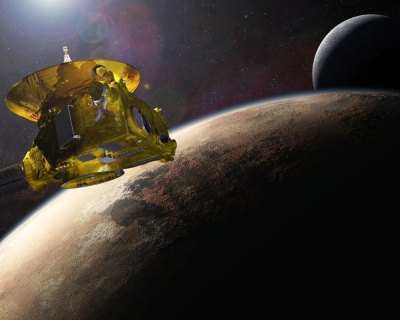
On July 14, NASA’s robotic New Horizons spacecraft will make “the first exploration of the Pluto system, the Kuiper Belt and the farthest shore of exploration ever reached by humankind,” said Alan Stern, New Horizons principal investigator from Southwest Research Institute in Boulder, Colorado, during a televised press conference April 14.
Stern used Census Bureau data to determine how many Americans were either too young to remember Voyager’s journey through the solar system in the 1980s or to have seen the first-time flyby of a planet.
“Surprisingly," he said, "it’s about half the people in the United States,and probably about half the people across the world have never seen anything like this before.”
Pluto is a distant yet familiar part of the solar system. Much public excitement is focused on exoplanets (planets outside our solar system). During the press conference, scientists confronted the issue of the distance to exoplanets, noting that the New Horizons spacecraft was launched nearly a decade ago -- Jan. 19, 2006 -- and is just now reaching Pluto. Given current technology, it is unlikely that we will be able to take a close-up look at an exoplanet in the near future. Pluto will have to do.
Here’s the rundown:
About Pluto:
Pluto was discovered by Clyde Tombaugh, an astronomer for the Lowell Observatory in Arizona, on Feb. 18, 1930. It is small -- about two-thirds the diameter of Earth’s moon, according to NASA. It has an atmosphere, seasons and at least five moons. Scientists believe Pluto may have an underground ocean – but they do not believe it supports life.
Is it a planet or what?
For years Pluto was regarded as the solar system’s ninth planet. It was “without context until the early 1990s,” says Stern, “when objects in the Kuiper Belt … began to be discovered. This was an amazing and fundamental change in our view of the solar system.”
In 2006, the International Astronomical Union reclassified Pluto as a dwarf planet.
Pluto’s largest moon is Charon, described by scientists as “Texas sized.” Pluto is also considered a binary planet – a term that describes two worlds similar in mass. “Each orbits the other around a gravitational balance point that is between the two -- a location called the center of mass,” according to NASA.
This is a mission of firsts:
To begin with, it is the first mission to Pluto, Stern says. “It’s also the fastest spacecraft ever launched. It’s the first mission to a binary planet. It is the first mission to the Kuiper Belt.”
The spacecraft will take photos, gather data about the planet and its atmosphere and even be able to take the surface's temperature, researchers said.
To know more:
NASA.gov: New Horizons
Related:
NASA spacecraft traverses Neptune's orbit